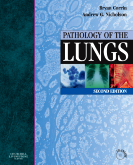|
|
|
| |
 |
|
|

|
 推薦指數:
推薦指數:





|
|
- 內容介紹
|
Pathology of the Lungs, 2nd Edition
By Bryan Corrin, MD, FRCPath and Andrew G. Nicholson, MA, MBBS, MRCPath, DM
Approx. 776 pages 989
Trim size 8 5/8 X 10 7/8 in
Copyright 2006
Description
With an emphasis on practical diagnostic problem solving, this New Edition provides readers with an accessible, comprehensive guide to the recognition and interpretation of neoplastic and non-neoplastic lung disorders. The text is lavishly illustrated with more than 989 high quality illustrations—more than 889 in full color—that accurately depict the histologic and cytologic findings under consideration. Readers will also find useful tips and advice from two internationally respected experts, as well as a user-friendly design and format that allow rapid access to essential information. The incorporation of relevant clinical and radiographic information renders this reference a complete diagnostic resource inside the reporting room.
Reviews
"Books of this size and significance are simply not written anymore by a single author. One must admire the effort and dedication of Professor Corrin, his meticulous perfectionism, and his devotion to beauty that pathologists periodically discover in their specimens...the text is comprehensive, informative, and authoritative."-Modern Pathology
Key Features
Covers both common and rare lung diseases and disorders.
Incorporates background and ancillary radiographs to create a more complete and accurate diagnostic report.
Includes an extensive reference list that highlights landmark articles.
Presents a user-friendly format that enables quick and easy navigation to key information.
New to this Edition
Discusses the latest advances in immunohistochemistry, utilizing all relevant laboratory-based modalities including cytogenetics.
Includes the most current classification and staging schemes for all pulmonary diseases and disorders.
Features the most up-to-date radiologic modalities, such as spiral and multi-slice CT.
Presents improved and expanded coverage of drug induced lung disease, idiopathic interstitial pneumonias, and neoplastic disease.
Uses more diagnostic flow charts, summary tables, and differential diagnosis tables, for easy evaluation and interpretation of similar entities.
|
|
|

